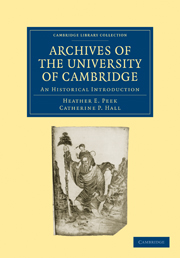Book contents
- Frontmatter
- Contents
- List of Plates
- Preface
- PART I
- PART II
- 4 The University and Colleges as Privileged Corporations
- 5 Records of University Administration
- 6 Records of Matriculation and Degrees
- 7 Financial Records of the University
- 8 Endowments of the University
- 9 University Officers and their Records
- 10 Records of the University Courts
- 11 Records of University Jurisdiction in the Town of Cambridge
- 12 The Relations between the Crown and the University
- 13 Other University Institutions and their Records
- APPENDICES
- Index
- Index to Muniments of Title in Appendix B
- Plate section
9 - University Officers and their Records
Published online by Cambridge University Press: 07 September 2010
- Frontmatter
- Contents
- List of Plates
- Preface
- PART I
- PART II
- 4 The University and Colleges as Privileged Corporations
- 5 Records of University Administration
- 6 Records of Matriculation and Degrees
- 7 Financial Records of the University
- 8 Endowments of the University
- 9 University Officers and their Records
- 10 Records of the University Courts
- 11 Records of University Jurisdiction in the Town of Cambridge
- 12 The Relations between the Crown and the University
- 13 Other University Institutions and their Records
- APPENDICES
- Index
- Index to Muniments of Title in Appendix B
- Plate section
Summary
Although at the present day the bulk of university teaching and university administration is carried out by a staff of salaried officers, supported by a body of university assistants, this state of affairs is relatively modern. Unlike the teaching posts, which from the sixteenth century to the nineteenth century depended almost entirely upon endowments, many of the administrative offices, especially those of the greatest antiquity and honour, derive from periods when quite other modes of appointment and emolument were customary. Sufficient relics of these older systems, embedded in the modern, remain to give to university life and ceremonial much of their distinctive quality, and to make the records of the various offices a rewarding subject of study. The offices have been of the greatest diversity, including graduate and non-graduate, resident and non-resident, and ranging from those of the highest honour, worthy to be held by magnates of the realm, to the humbler posts, such as those of the university plumber and pewterer. For convenience, they can be considered in a few general groups, according to the mode of appointment, tenure, and emoluments of office.
In the impecunious medieval university, the burden of office was, on the whole, expected to be heavier than the rewards, and a system was evolved by which office-holders changed annually or biennially. Appointment to administrative office was by election made according to forms prescribed in the statutes. Bonds against non-performance of duty were taken from persons entering upon their term of office and a detailed indenture between the outgoing officer and his successor served for the acquittance of the former.
- Type
- Chapter
- Information
- Archives of the University of CambridgeAn Historical Introduction, pp. 41 - 48Publisher: Cambridge University PressPrint publication year: 1963First published in: 1962



